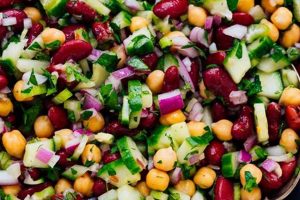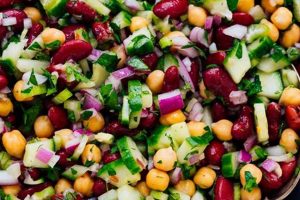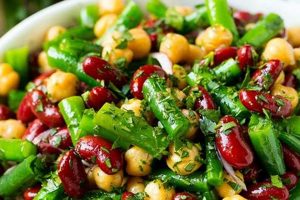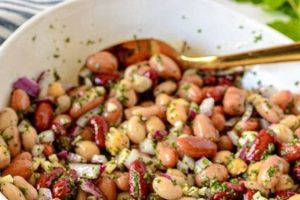This dish typically combines black beans, corn kernels, and diced avocado, often complemented by other ingredients like red onion, bell pepper, cilantro, and lime juice. Variations may include other beans, different herbs, or spices, and the dressing can range from a simple vinaigrette to a creamy cilantro-lime dressing. A basic preparation involves combining the core ingredients in a bowl, adding chosen extras, and tossing with the preferred dressing. It can be served as a light lunch, a side dish, or a component of a larger meal.
The combination of beans, corn, and avocado offers a nutritious and flavorful meal option. Beans contribute protein and fiber, corn provides carbohydrates and vitamins, and avocado adds healthy fats. This blend results in a dish rich in essential nutrients while being relatively low in calories. Furthermore, the versatility of this dish allows for easy adaptation to dietary needs and preferences. Ingredients can be substituted or omitted to create vegan, gluten-free, or other variations. Historically, the individual components have played significant roles in different cuisines, particularly in Central and South American cooking, with the combined salad emerging as a popular modern dish.
The following sections will delve into specific aspects of this culinary creation, including variations on the basic recipe, nutritional information, tips for preparation and storage, and suggestions for serving.
Tips for Preparing a Flavorful Salad
Optimizing ingredient selection and preparation techniques can significantly enhance the final dish. Attention to detail ensures a vibrant, flavorful, and texturally pleasing salad.
Tip 1: Ripe Avocados are Key: Select avocados that yield to gentle pressure but are not overly soft. Overripe avocados can result in a mushy texture.
Tip 2: Fresh Corn Enhances Flavor: Whenever possible, use fresh corn kernels cut from the cob. Frozen corn can be substituted, but ensure it is thawed and drained thoroughly.
Tip 3: Rinse Canned Beans: Rinsing canned black beans removes excess sodium and starch, improving both flavor and texture.
Tip 4: Balance Acidity: Lime juice provides essential acidity. Adjust the amount according to personal preference and the overall flavor profile of the salad.
Tip 5: Enhance with Fresh Herbs: Fresh cilantro is a classic pairing. Other herbs like parsley or mint can also be incorporated for a unique flavor profile.
Tip 6: Consider Textural Variety: Adding diced red onion or bell pepper introduces a pleasant crunch.
Tip 7: Proper Storage Maintains Freshness: Store leftover salad in an airtight container in the refrigerator for up to three days. To prevent browning, place a piece of plastic wrap directly on the surface of the salad before sealing the container.
By following these tips, one can create a vibrant and satisfying salad that maximizes flavor and freshness.
These tips offer a starting point for creating delicious variations. Experimentation with different ingredients and flavor combinations is encouraged.
1. Ingredients
Ingredient selection directly impacts the flavor, texture, and nutritional profile of this salad. The core componentsblack beans, corn, and avocadoprovide a foundation of protein, fiber, healthy fats, and complex carbohydrates. Each ingredient contributes distinct characteristics. Black beans offer a mild, earthy flavor and a substantial texture. Corn provides sweetness and a pop of brightness. Avocado lends creaminess and a subtle, buttery taste. The quality and freshness of these core ingredients are paramount to the overall success of the dish. For example, using canned black beans versus freshly cooked ones can affect both taste and texture. Similarly, fresh corn off the cob will offer a superior sweetness compared to frozen kernels. Ripe, but not overripe, avocados are essential for achieving the desired creamy texture without mushiness.
Beyond the core triad, supplementary ingredients further enhance complexity and offer opportunities for customization. Red onion adds a pungent bite, while bell peppers introduce sweetness and crunch. Cilantro provides a fresh, herbaceous note. Lime juice contributes essential acidity, balancing the richness of the avocado and brightening the overall flavor profile. These supporting ingredients can be adjusted to cater to individual preferences or dietary restrictions. Substituting red onion with milder shallots, or omitting cilantro altogether, exemplifies the adaptability of this recipe. The interplay of these ingredients creates a vibrant and balanced flavor profile.
Careful consideration of each ingredientfrom the core components to the supporting elementsis crucial for a successful outcome. Understanding the role and impact of each element allows for informed substitutions and creative variations, ensuring a delicious and satisfying salad every time. Ingredient quality directly influences the nutritional value as well, maximizing the health benefits of this dish. Sourcing fresh, high-quality ingredients whenever possible elevates the overall sensory experience and nutritional impact.
2. Preparation
Proper preparation techniques are crucial for maximizing the flavor, texture, and overall quality of a black bean corn avocado salad. Careful handling and timing ensure that each ingredient contributes optimally to the final dish. The following facets of preparation highlight key considerations for achieving a successful outcome.
- Knife Skills and Cutting Techniques
Consistent sizing of ingredients promotes even flavor distribution and enhances the visual appeal of the salad. Dicing the avocado, red onion, and bell peppers into uniform pieces ensures that each bite contains a balanced combination of flavors and textures. Precise knife work also prevents the avocado from becoming bruised or overly mashed during the preparation process. Uniformly sized corn kernels, whether derived from fresh cobs or frozen packages, contribute to a harmonious textural experience.
- Ingredient Handling and Order of Operations
Gentle handling of the avocado is essential to maintain its delicate texture. Adding acidic elements like lime juice to the avocado helps prevent browning. Incorporating the more delicate ingredients, such as the avocado and fresh herbs, towards the end of the preparation process helps preserve their structure and prevents them from becoming over-mixed or damaged. The order in which ingredients are combined can also affect the overall balance of flavors.
- Dressing Preparation and Emulsification
Proper emulsification of the dressing, if applicable, ensures a smooth and evenly distributed coating over the salad components. Whisking together the oil, acid, and seasonings creates a stable emulsion that clings to the ingredients, enhancing flavor delivery. The type of dressing chosen, whether a simple vinaigrette or a creamy cilantro-lime dressing, influences the overall flavor profile and textural experience.
- Timing and Serving Temperature
Consuming the salad shortly after preparation maximizes freshness and prevents the avocado from oxidizing. Chilling the salad for a brief period can enhance the flavors but should be approached cautiously to avoid making the ingredients too cold, which can dull their taste. Serving the salad at the optimal temperature enhances the overall sensory experience.
Careful attention to these preparation steps elevates the black bean corn avocado salad from a simple combination of ingredients to a vibrant and flavorful dish. Precise knife skills, proper ingredient handling, appropriate dressing preparation, and attention to timing contribute to a superior culinary experience. Mastering these techniques allows for consistent and high-quality results.
3. Flavor Balance
Flavor balance is paramount in a successful black bean corn avocado salad. The dish thrives on the interplay of contrasting yet complementary tastes. The inherent mildness of black beans and corn provides a neutral canvas for other, more assertive flavors. Avocado contributes a creamy richness and subtle nuttiness, while acidity from lime juice is crucial for balancing the richness and preventing the salad from tasting bland. The savory depth of ingredients like red onion or spices like cumin provides further complexity. A well-balanced salad avoids any single flavor dominating, creating a harmonious and refreshing culinary experience. For instance, an excess of lime juice can overwhelm the other flavors, while insufficient seasoning can leave the dish tasting flat. Achieving balance necessitates careful consideration of ingredient proportions and the interplay of sweet, salty, acidic, and savory elements.
The concept of flavor balance extends beyond individual ingredients to encompass the overall composition of the salad. The creamy texture of avocado complements the firmer textures of beans and corn, while the addition of crunchy elements like red onion or bell pepper provides textural contrast. This interplay of textures enhances the eating experience and contributes to the overall perception of balance. The choice of dressing also plays a significant role. A light vinaigrette enhances the natural flavors of the ingredients, while a creamy dressing adds a layer of richness and can further contribute to the balance of flavors. Understanding the impact of each component on the overall flavor profile allows for informed adjustments to achieve the desired balance. One might, for example, increase the amount of cilantro to amplify the fresh, herbaceous notes or add a pinch of chili flakes for a touch of heat.
Mastering flavor balance in this salad involves not only understanding the individual characteristics of each ingredient but also appreciating how these flavors interact and contribute to the overall sensory experience. This understanding enables the creation of a dish that is both complex and harmonious, where each flavor plays a distinct yet integrated role. The practical significance lies in the ability to adjust the recipe to suit individual preferences, ensuring a consistently delicious and satisfying outcome. Challenges may arise in balancing the inherent sweetness of corn with the other flavors, particularly if using frozen or canned kernels, which can sometimes be less sweet than fresh corn. Adjusting the acidity and seasonings accordingly addresses this challenge and maintains overall harmony.
4. Nutritional Value
Nutritional value represents a significant aspect of the black bean corn avocado salad recipe. This dish offers a compelling combination of macronutrients, micronutrients, and beneficial plant compounds. Understanding the nutritional composition allows for informed dietary choices and highlights the health benefits associated with consuming this salad.
- Macronutrient Profile
This salad provides a balanced source of macronutrients, including complex carbohydrates from corn, protein from black beans, and healthy fats from avocado. This combination contributes to satiety and provides sustained energy. The fiber content, primarily from the beans and corn, supports digestive health and can help regulate blood sugar levels. For example, a one-cup serving of black beans provides approximately 15 grams of fiber. The specific macronutrient ratios can be adjusted based on individual dietary needs by modifying portion sizes or adding other ingredients.
- Micronutrients and Vitamins
The salad offers a variety of essential micronutrients. Black beans are a good source of iron and folate, while corn provides vitamin C and magnesium. Avocado contributes potassium and vitamin K. These micronutrients play crucial roles in various bodily functions, from red blood cell production to bone health. The inclusion of other vegetables, such as bell peppers, can further enhance the micronutrient profile. Red bell peppers, for instance, are rich in vitamin A.
- Antioxidants and Phytochemicals
The ingredients in this salad offer a range of antioxidants and phytochemicals, which are beneficial plant compounds. These compounds can protect cells from damage caused by free radicals and may contribute to reducing the risk of chronic diseases. Avocados, for example, contain carotenoids, while black beans are rich in anthocyanins. These compounds also contribute to the vibrant colors of the salad ingredients.
- Dietary Considerations and Adaptations
The recipe is naturally vegan and gluten-free, making it suitable for individuals with these dietary restrictions. It can also be easily adapted to address other dietary needs. For individuals managing sodium intake, rinsing canned beans thoroughly is recommended. Portion control can be utilized to manage calorie intake or adjust macronutrient ratios. The recipe’s flexibility allows for substitutions based on individual preferences and nutritional goals. For example, quinoa can be added for additional protein and fiber.
The nutritional value of the black bean corn avocado salad makes it a healthy and versatile meal option. Its balanced macronutrient profile, combined with the array of micronutrients, antioxidants, and phytochemicals, contributes to overall well-being. The adaptability of the recipe allows it to be tailored to various dietary needs and preferences, further enhancing its value as a nutritious and flavorful dish. Regular inclusion of this salad in a balanced diet can contribute to long-term health benefits.
5. Serving Suggestions
Serving suggestions enhance the versatility of the black bean corn avocado salad recipe, transforming it from a simple side dish to a central component of diverse meals. Consideration of complementary flavors, textures, and overall nutritional balance guides serving suggestions. The salad’s inherent adaptability allows for integration into various culinary contexts, expanding its appeal and practical applications. For instance, the salad pairs well with grilled fish or chicken, offering a light yet satisfying meal. The fresh, vibrant flavors of the salad contrast and complement the richness of grilled proteins. Alternatively, the salad can be served as a filling for tacos or burritos, adding a nutritious and flavorful dimension to these popular dishes. The salad’s textural complexity contributes to a more satisfying culinary experience in these applications. As a dip with tortilla chips, the salad provides a healthier alternative to traditional dips, offering a refreshing and flavorful snacking option.
Practical applications extend beyond specific pairings to encompass broader meal planning strategies. The salad can be prepared in advance, making it a convenient option for busy weeknights or packed lunches. Its adaptability extends to seasonal variations, allowing for the incorporation of readily available produce. For example, during summer months, incorporating grilled peaches or watermelon can add a seasonal twist. Similarly, substituting corn with roasted butternut squash during the fall provides a heartier and seasonally appropriate variation. These adjustments not only reflect seasonal availability but also demonstrate the recipe’s adaptability to different flavor profiles and dietary preferences. Understanding the nutritional profile of the salad enables strategic pairing with other dishes to create balanced and complete meals. Serving the salad alongside a lean protein and a whole-grain carbohydrate source provides a well-rounded and nutritious meal option. The salad can also be incorporated into meal prepping strategies, facilitating healthy eating habits throughout the week.
Effective serving suggestions elevate the black bean corn avocado salad from a standalone dish to a versatile culinary component. Understanding complementary flavors and textures enables creative pairings and facilitates seamless integration into diverse meals. This adaptability extends to seasonal variations and meal planning strategies, demonstrating the practical significance of serving suggestions in maximizing the recipe’s potential. Challenges may arise in adapting the salad to certain dietary restrictions or cultural preferences. Careful consideration of ingredient substitutions and flavor adjustments addresses these challenges, ensuring the salad remains a versatile and appealing option for a wide range of individuals.
6. Storage Techniques
Storage techniques significantly impact the quality and longevity of a black bean corn avocado salad. Proper storage preserves the vibrant colors, fresh flavors, and desirable textures of the individual components, preventing premature spoilage and maximizing the salad’s shelf life. This is particularly crucial due to the avocado’s susceptibility to oxidation, which results in browning and undesirable flavor changes. Effective storage mitigates these risks, ensuring the salad remains palatable and visually appealing.
Several factors influence optimal storage. Airtight containers are essential for minimizing exposure to oxygen, a primary driver of avocado browning. Storing the salad in the refrigerator at temperatures between 34F and 40F (1C and 4C) further slows enzymatic activity that contributes to spoilage. A practical technique involves placing a piece of plastic wrap directly on the surface of the salad before sealing the container. This creates a barrier against oxygen, further protecting the avocado from browning. The duration of safe storage is typically limited to three days, even with optimal techniques. Beyond this timeframe, quality degradation becomes more pronounced, and the risk of bacterial growth increases. For instance, if a large batch of salad is prepared for a gathering, dividing it into smaller, airtight containers before refrigeration optimizes storage efficiency and minimizes waste. Similarly, if the salad is intended for a packed lunch, using an insulated container with ice packs helps maintain a safe temperature and preserves quality.
Understanding and implementing appropriate storage techniques is essential for maximizing the enjoyment and safety of a black bean corn avocado salad. While the inherent perishability of certain ingredients presents challenges, strategic storage practices mitigate these challenges and extend the salad’s shelf life. Proper storage contributes not only to preserving flavor and appearance but also to minimizing food waste and maximizing the value of the ingredients. Failure to adhere to recommended storage practices can result in a less palatable and potentially unsafe product, highlighting the practical significance of this understanding within the broader context of food safety and culinary best practices.
7. Variations
Variations on the black bean corn avocado salad recipe demonstrate the dish’s adaptability and highlight the potential for customization based on individual preferences, dietary needs, and seasonal ingredient availability. The core componentsblack beans, corn, and avocadoprovide a foundational flavor profile, while variations introduce diverse ingredients and culinary influences, expanding the recipe’s versatility. This adaptability contributes to the salad’s widespread appeal and its suitability for various culinary contexts. For example, substituting mango for corn introduces a tropical twist, while adding grilled chicken or fish transforms the salad into a complete meal. The inclusion of different herbs and spices, such as jalapeo or cumin, further expands the flavor possibilities.
Several factors drive the development of variations. Dietary restrictions often necessitate ingredient substitutions. For individuals following a low-sodium diet, using low-sodium or no-salt-added canned beans, or cooking beans from scratch, becomes essential. Similarly, adapting the recipe for gluten-free diets requires careful attention to ingredient selection, ensuring all components, including dressings and seasonings, are gluten-free. Cultural preferences also influence variations. Incorporating regional spices or herbs aligns the salad with specific culinary traditions. For instance, adding achiote paste or adobo seasoning introduces Latin American influences. Seasonal ingredient availability presents opportunities to incorporate fresh, locally sourced produce. Substituting corn with roasted sweet potatoes during the fall, or adding fresh berries in the summer, exemplifies this seasonal adaptation. These variations not only reflect culinary creativity but also contribute to a more sustainable and environmentally conscious approach to cooking.
The ability to create variations on the black bean corn avocado salad highlights the recipe’s fundamental strength and its enduring appeal. Adaptability empowers individuals to tailor the dish to specific needs and preferences, ensuring a consistently satisfying and personalized culinary experience. Challenges may arise in maintaining flavor balance and nutritional integrity when introducing variations. Careful consideration of ingredient substitutions and their impact on the overall flavor profile and nutritional composition addresses these challenges. A deep understanding of the core recipe principles facilitates informed experimentation and ensures that variations remain true to the essence of the dish while simultaneously offering exciting new flavor combinations and culinary experiences.
Frequently Asked Questions
This section addresses common inquiries regarding the preparation, storage, and variations of this salad.
Question 1: How can browning of the avocado be prevented after the salad is prepared?
Limiting exposure to oxygen is crucial. Storing the salad in an airtight container and placing plastic wrap directly on the surface minimizes oxidation. Adding lime juice also helps slow the browning process.
Question 2: What are suitable substitutes for black beans?
Kidney beans, pinto beans, or chickpeas offer comparable flavor profiles and nutritional benefits. These substitutes maintain the salad’s heartiness and textural integrity.
Question 3: Can frozen corn be used instead of fresh corn?
Frozen corn is acceptable, but ensure it is thawed and drained thoroughly before incorporating it into the salad. Fresh corn, however, offers superior sweetness and texture.
Question 4: How long can the salad be safely stored in the refrigerator?
Properly stored in an airtight container, the salad typically remains safe for consumption for up to three days. Beyond this period, quality degrades, and the risk of spoilage increases.
Question 5: Can this recipe be adapted for a low-sodium diet?
Rinsing canned beans thoroughly reduces sodium content. Using low-sodium or no-salt-added canned beans, or cooking beans from scratch, further minimizes sodium levels.
Question 6: What dressings complement this salad beyond a simple vinaigrette?
A creamy cilantro-lime dressing provides a richer flavor profile. Alternatively, a light dressing based on Greek yogurt offers a tangy and refreshing complement.
Addressing these common queries provides clarity regarding optimal preparation and storage methods, ingredient substitutions, and flavor variations. This knowledge ensures a successful and enjoyable culinary experience.
The following section provides a complete recipe for a classic black bean corn avocado salad.
Black Bean Corn Avocado Salad Recipe
This exploration of the black bean corn avocado salad recipe has highlighted its versatility, nutritional value, and adaptability. From ingredient selection and preparation techniques to flavor balance, storage methods, and serving suggestions, each aspect contributes to the dish’s overall success. The recipe’s inherent simplicity allows for creative variations while maintaining its core nutritional benefits. Understanding the interplay of flavors and textures empowers culinary exploration, enabling adaptation to individual dietary needs and preferences.
The black bean corn avocado salad recipe represents more than a simple combination of ingredients; it embodies a culinary synthesis of flavor, nutrition, and adaptability. Its capacity for customization ensures its continued relevance in diverse culinary landscapes, offering a refreshing and nutritious option for both everyday meals and special occasions. Further exploration of regional variations and innovative ingredient combinations promises to expand the culinary potential of this versatile dish.






